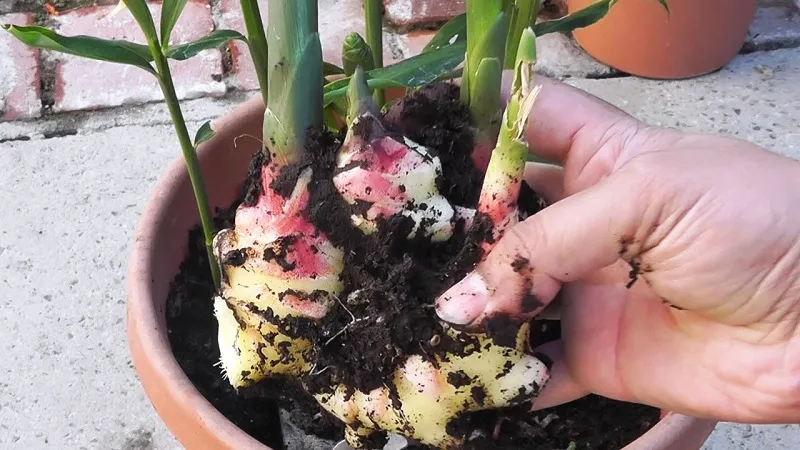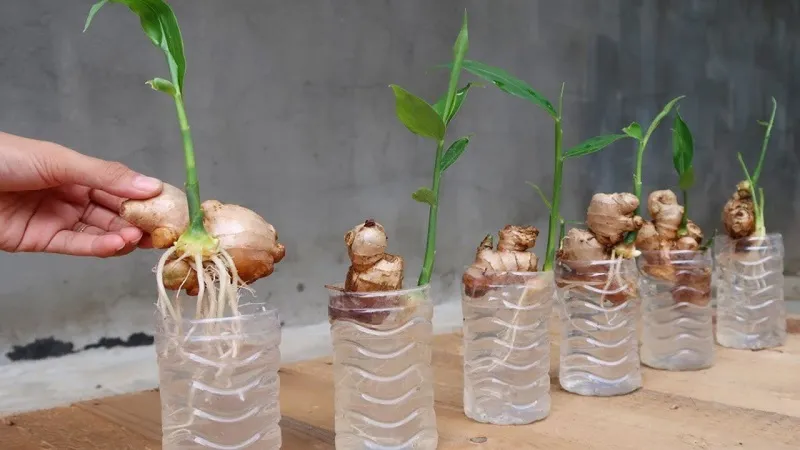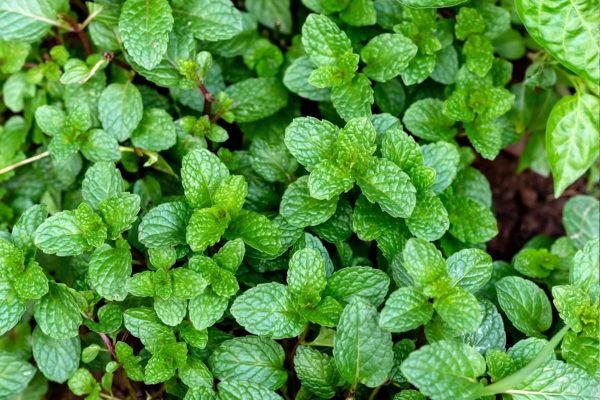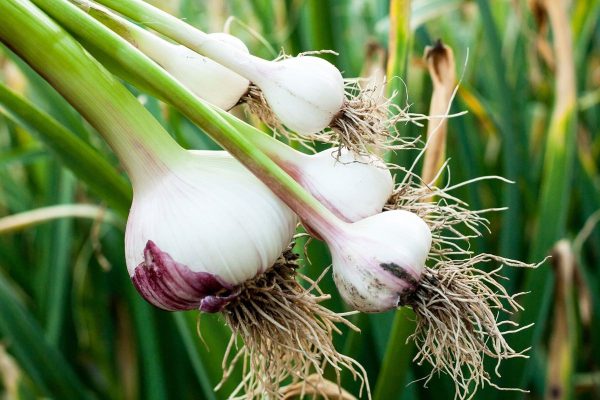Plants
Ginger
Introduction / परिचय
Ginger, known botanically as Zingiber officinale, is a tropical flowering plant prized for its rhizomes, which are the knobby, aromatic underground stems. Widely celebrated for its culinary, medicinal, and aromatic properties, ginger has earned a prominent place in global cultures. Its distinctive, slightly spicy flavour adds depth to a range of sweet and savoury dishes. Beyond the culinary realm, ginger boasts a rich history of traditional medicine usage for its potential health benefits. Its knotted rhizomes produce the familiar spice, ginger, and are celebrated for their versatility. In this guide, we'll delve into ginger plants' cultivation, uses, and benefits.
Also Read This :How to Grow Sunflower from Seeds At Home
| English Name: | Ginger |
| Hindi Name: | अदरक (Ginger) |
| Scientific Name: | Zingiber officinale |
| Family: | Ginger Family |
| Kingdom: | Plantae |
| Light : | Partial to Full Shade |
| Height: | 3-4 feet tall |
| Flower Color : | Red, orange, yellow |
| Leaves Color : | Green |
| Eason Features : |
Also Read This :Greening Your Home: The Benefits of Indoor Plants
When to Plant Ginger
Ginger (Zingiber officinale) is a tropical plant known for its aromatic and flavorful rhizomes, commonly used in cooking and for their potential health benefits. The best time to plant ginger depends on your climate and local conditions. Here are some general guidelines:
Tropical and Subtropical Climates:
Ginger can be planted throughout the year in regions with warm, tropical, or subtropical climates. However, the ideal time is during the rainy or warmer months when the soil is consistently warm, and there's plenty of moisture.
Temperate Climates:
In temperate regions, where winters can be cold, ginger is typically planted in the spring or early summer. Wait until the last frost has passed and the soil has warmed to around 70°F (21°C) before planting.
Indoor Cultivation:If you're growing ginger indoors in pots, you can plant it year-round. However, you might see the best results starting in the early spring or autumn when indoor temperatures are favourable.
Also Read This :Easy way to grow Strawberry at Home
Flowering time of Ginger
Ginger is a tropical and subtropical plant renowned for its aromatic rhizomes used in cooking and herbal medicine. Its flowering time varies based on growing conditions. In its natural habitat, ginger produces flowers in late summer or early fall. However, when cultivated in non-native regions or as a potted plant, it may not flower at all. The rhizomes, which are the primary ginger harvest, are typically harvested before the plant reaches its flowering stage. When ginger does flower, it produces unique and delicate inflorescences with white or yellow petals, adding a touch of exotic beauty to its lush green foliage.

Also Read This :What is Coco peat ? & How to Make Coco peat at Home
Varieties / किस्मे
Ginger (Zingiber officinale) is a widely cultivated and versatile plant known for its aromatic and flavorful rhizomes. There are several varieties and cultivars of ginger, each with unique characteristics and uses. Here are some of the common varieties:
Common or Culinary Ginger (Zingiber officinale):
This ginger is most commonly found in grocery stores. It's used for cooking and has a pungent, spicy flavour. Varieties of culinary ginger include:- Indian Ginger (Amrita): Widely used in Indian cuisine, it has a strong and spicy flavour.
- Chinese or Yellow Ginger: Milder in flavour, it's often used in Chinese cooking and pickled dishes.
Baby Ginger (Zingiber officinale var. rubrum):
Baby ginger is harvested earlier when the rhizomes are young and tender. It has a milder flavour and can be used in various culinary applications.
Galangal (Alpinia galanga):
Often called Thai ginger, galangal has a distinct, sharp, and citrusy flavour. It's used in Thai and Indonesian cuisine, particularly in curries and soups.African Ginger (Afrocardamom or African Horned Ginger):
This variety is native to West Africa and is used in traditional herbal medicine and cooking.
White Ginger Lily (Hedychium coronarium):
Although not an actual ginger, it's known as white ginger or butterfly ginger. It's prized for its fragrant white flowers and often grown for ornaments.
Turmeric (Curcuma longa):
Turmeric is a close relative of ginger and is well-known for its bright orange rhizomes. It's a key ingredient in curry powders and has gained popularity for its potential health benefits.
Blue Hawaiian Ginger (Dichorisandra thyrsiflora):
Not related to culinary ginger, this plant is grown for its striking blue-purple flowers and is used as an ornamental plant.
Ginger Lily (Hedychium spp.):
These ornamental gingers are known for their large, showy flowers and are commonly grown in gardens.
While these are some of the most recognized varieties of ginger, there are many more species and cultivars with unique flavours, appearances, and uses. The choice of ginger variety often depends on culinary preferences, growing conditions, and regional traditions.
Also Read This :12 Delicious and Nutritious Herbal Teas to Boost Your Health
Classification of Plants/ पौधों का वर्गीकरण
Ginger plants belong to the Zingiberaceae family and are classified into various species and cultivars. The most well-known and widely cultivated ginger isZingiber officinale, or "culinary ginger." Additionally, the classification of ginger plants includes:
Wild Gingers (Asarum):
These are not closely related to culinary ginger and are found in North America, Europe, and Asia.
Ornamental Gingers:
These are grown for their aesthetic qualities and include various species likeAlpinia,Hedychium, andCostus.
Aromatic Gingers:
This category includes gingers likeKaempferia, known for their fragrant rhizomes and used in traditional medicines and perfumery.
Medicinal Gingers:
Certain gingers are used in traditional medicine, such asCurcuma longa, commonly known as turmeric.
Each ginger variety or species may have unique properties, uses, and cultivation requirements, making ginger plants a diverse and fascinating botanical group.
Also Read This :10 Summer Solutions: How to Safeguard Your Balcony Garden from Heat Stress and More
History / इतिहास
Ginger is a spice and medicinal plant with a history of over 5,000 years. Native to Southeast Asia, it was highly prized in ancient India and China for its culinary and medicinal uses. Ginger played a crucial role in the spice trade, and its introduction to the Mediterranean through the Silk Road revolutionized European cuisine. It was among the first spices early explorers brought to the New World. Ginger's popularity soared in Europe during the Middle Ages, and it remains a vital ingredient in global cuisines and traditional remedies, valued for its distinctive flavour and health benefits.

Also Read This :Discover the Secrets to Growing Beautiful Cardamom Plants!
Uses and Benefits / उपयोग एवं फायदे
Ginger (Zingiber officinale) is a versatile and prized herb with diverse uses and numerous health benefits. Its fresh or dried rhizome adds a zesty, aromatic flavour to culinary dishes and beverages. Ginger is celebrated for its potential to alleviate nausea, aid digestion, and reduce inflammation. It has been a staple in traditional medicine for treating various ailments, including colds, digestive issues, and muscle pain. Ginger also offers potential benefits in managing motion sickness, morning sickness during pregnancy, and reducing menstrual discomfort. With its culinary versatility and medicinal properties, ginger remains a valuable ingredient for health and culinary enthusiasts.
Also Read This :Rubber Plants: A Beginner’s Guide to Growing and Maintaining Them
How to Grow Plant / कैसे उगाएं
Growing Ginger (Zingiber officinale) at home is a rewarding endeavour. To start, obtain fresh ginger rhizomes from a grocery store or nursery. Choose plump, healthy rhizomes with well-developed "eyes." Plant them in a pot or directly in the ground, ensuring the eyes face up and the rhizomes are covered with soil. Ginger thrives in well-draining, rich soil with partial sunlight. Water it regularly, keeping the soil consistently moist but not soggy. In about 8-10 months, you can harvest ginger by carefully digging up a portion of the rhizome. Homegrown ginger offers a fresh and aromatic addition to your culinary creations.
Also Read This :2 Method to Grow Ginger (Adrak) at HomeHow to Take Care/ देखभाल कैसे करे
Caring for ginger plants (Zingiber officinale) is relatively simple. Start by planting rhizomes (ginger "roots") in well-draining, rich soil during the spring. Ensure they're kept in a warm, humid environment, such as a greenhouse or indoors. Ginger prefers filtered sunlight and protection from strong winds. Keep the soil moist but not waterlogged, as ginger detests saturated conditions. Fertilize with a balanced, water-soluble fertilizer every two to three weeks during the growing season. Prune any yellow or dead leaves as needed. Ginger can take up to 10-12 months to reach maturity. Harvest when the plant is around 8-10 months old or when the leaves turn yellow and die back.
Also Read This :3 Method to Grow Mint (Pudina) at Home
Interesting Facts / रोचक तथ्य
Ginger plants (Zingiber officinale) offer fascinating characteristics and uses. Notably, ginger is a versatile spice and a medicinal herb known for its anti-inflammatory and digestive properties. This tropical plant produces distinctive flowers in various colours, including pink and white. Ginger's rhizomes are the edible part used in cooking, while the plant's leaves are not commonly consumed. It can be grown indoors or outdoors and thrives in warm, humid climates. Ginger's historical use dates back over 5,000 years, originating in Southeast Asia and spreading globally. It remains an essential ingredient in cuisines, herbal remedies, and even a fragrant addition to gardens.
Also Read This :How To Grow Gazania Flower at Home




